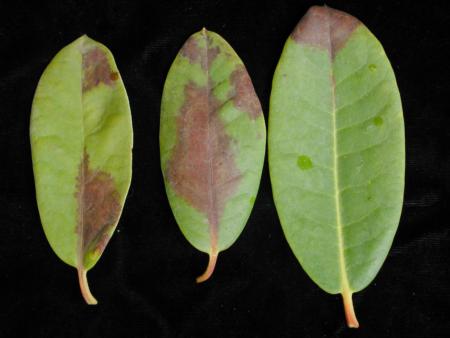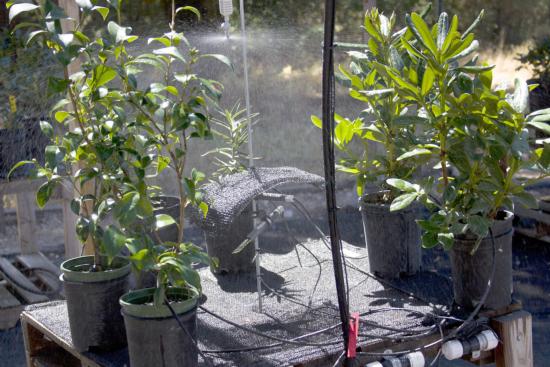Fall 2011: Environmental conditions could be monitored in the nursery to limit the spread of sudden oak death
Regional Report for Santa Cruz and Monterey Counties by Steve Tjosvold
Sudden oak death (SOD) is a disease that has spread to new areas in the United States by ornamental nursery stock. It is likely that it will eventually establish in eastern forests and wildlands with yet unknown impact. The causal agent of the disease, Phytophthora ramorum, is a water mold that produces aerial spores (sporangia and zoospores) capable of being spread by splashing rainfall and sprinkler irrigation to adjacent plants and by water runoff, streams and other waterways. Although we know much about how temperature and moisture influence the production of spores in the laboratory, no studies, until the one we have just completed, has determined how these factors are integrated under nursery conditions.
Experimental factors we studied for two years included the effect of season, temperature, leaf wetness, lesion size and age on spore production of the pathogen on two important ornamental hosts (camellia and rhododendron) and one epidemiologically important forest host (California bay). Experimental leaf wetness regimes were established with overhead misting to simulate rainfall, fog, dew, or conditions that might occur in an overhead irrigated nursery or landscape.
A research paper was recently presented at a scientific meeting on our findings, and for this report, we present the general findings and conclusions as to how this information might be implemented into nursery practices.
As expected, spores were most likely produced with simulated rainfall, followed by simulated fog, followed by natural conditions. Sporulation remained fairly constant in the 50 oF to 86 oF (10 oC to 30 oC) range, given sufficient leaf moisture, but stopped quickly when maximum daily temperatures were above about 91 oF (33 oC) in all species. Sporulation increased logarithmically with increasing consecutive hours of leaf wetness. Sporulation on California bay and rhododendron began at the onset of leaf wetness, while camellia began to sporulate in about 8 hours. For all species, the highest rate of sporulation was seen after 1 day of artificial misting (fog or rain conditions), with the highest level after 4 days. Over 1 day of leaf wetness was necessary to detect significant sporulation in camellia and rhododendron, but in California bay, sporulation was measured at the end of the first day. Lesion size on rhododendron and California bay plants did not predict sporulation well, and was not significant for camellia; therefore lesion size was not included in the final statistical models. However, lesion age was a much stronger predictor of sporulation (fig. 1). Sporulation increased from 3 weeks age to 9 weeks for California bay, from 3 weeks to 6 or 9 weeks for camellia, but decreased from 3 weeks to 6 or 9 weeks for rhododendron. Sporulation often occurred in the spring and fall when clear cold nights produced heavy natural fog on the top and bottom of leaves.

Fig. 1. Leaf lesions on rhododendron caused by Phytophthora ramorum. Lesion age is a stronger predictor of sporulation than lesion size. Photo by S. Tjosvold.
Using this information and readily available electronic environmental sensors (such as the equipment used in this experiment, illustrated in fig. 2.), nursery operators could monitor environmental conditions and in high-risk temperature and leaf-wetness conditions, avoid certain cultural practices such as plant handling or pruning that might increase the chance of infection. Likewise, avoid conditions such as overhead irrigation that would lengthen the duration of leaf wetness which would logarithmically increase the production of spores. Further, preventative fungicides could be applied at times when there is a high risk of sporulation.

Fig. 2. To simulate fog or rain to test different leaf wetness regimes on Phytophthora ramorum sporulation, an Onset U-30 WiFi wireless datalogger with relay was used in conjunction with an Onset LW-1 Leaf Wetness sensor to control Netafim (Tel Aviv, Israel) Vibronet Misters (# 0354025-B). Photo by S. Tjosvold.












